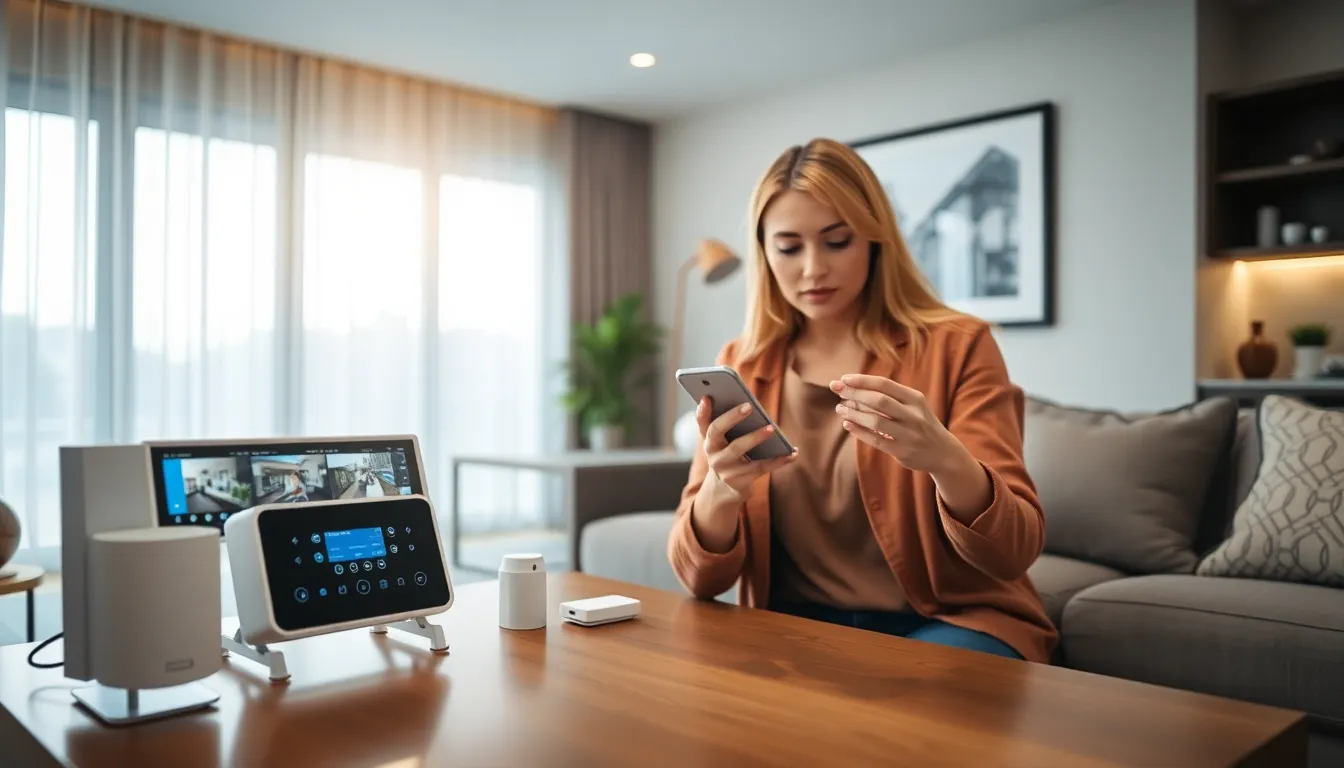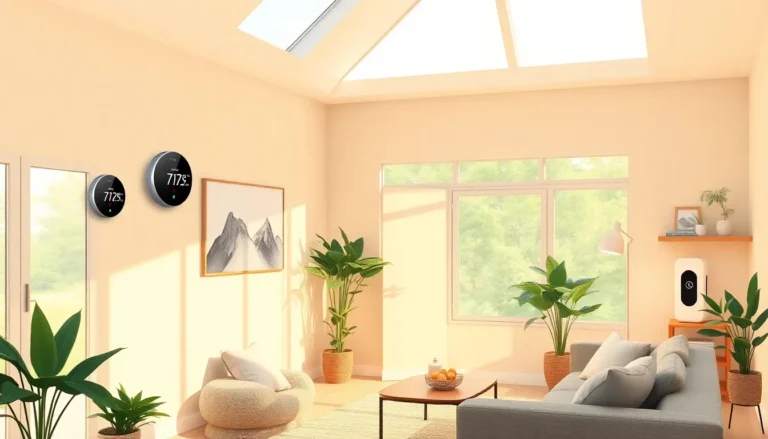In a world where even your toaster can connect to the internet, why should your home security be stuck in the Stone Age? Enter the connected alarm system, the superhero of home safety that never takes a day off. With its ability to keep an eye on things while you binge-watch your favorite shows, this tech-savvy solution is here to save the day—one alert at a time.
Imagine receiving real-time notifications right on your phone while you’re out enjoying a latte. No more worrying about whether you remembered to lock the door. A connected alarm system gives peace of mind and turns your home into a fortress—minus the moat and the drawbridge. It’s time to embrace the future of home security and ensure your castle remains safe from unwanted visitors. Who knew protecting your home could be this easy—and entertaining?
Table of Contents
ToggleOverview of Connected Alarm Systems
Connected alarm systems enhance home security through advanced technology. These systems integrate various devices, including cameras, sensors, and alarms, all linked to a central hub. Real-time alerts send notifications directly to homeowners, whether they are at home or away. Users can monitor their property via smartphone applications, providing peace of mind and control.
Features in connected alarm systems commonly include motion detection. Sensors trigger alarms when movement occurs in designated areas, ensuring swift action can be taken. Video surveillance equipped with high-definition cameras allows for clear visual monitoring of the property. Some systems even offer night vision capabilities, enhancing security during low-light conditions.
Integration with smart home technology is another advantage. Connected alarm systems often communicate with other devices, like smart locks or lighting. This interoperability can create automated responses, such as locking doors or illuminating entryways when alarms activate. Such automation not only adds convenience but also strengthens overall security.
Scalability is a key aspect of these systems. Users can easily expand their alarm systems as needed, adding more sensors or cameras to accommodate larger properties or changing security needs. This flexibility ensures that connected alarm systems adapt alongside growing safety concerns.
Data storage options further augment functionality. Cloud-based storage allows for easy access to recorded footage and event logs. Homeowners benefit from the ability to review past incidents, aiding in investigations or providing evidence if needed.
Connected alarm systems represent a significant evolution in security technology. They combine convenience, flexibility, and integrated monitoring, addressing modern security challenges effectively.
Benefits of Connected Alarm Systems

Connected alarm systems provide multiple advantages, enhancing home security and user experience.
Enhanced Security Features
Connected alarm systems offer advanced security features that elevate protection for homeowners. Motion detection sensors alert users about any unusual activity. High-definition cameras capture clear footage, even in low-light conditions, ensuring comprehensive surveillance. Integration with smart home devices allows automated responses to threats. For instance, lights may turn on or locks may engage automatically when motion is detected. Regular software updates improve system effectiveness and address security vulnerabilities. These features combine to create a robust security network that adapts to various environments and user needs.
Remote Monitoring Capabilities
Remote monitoring capabilities significantly improve how homeowners manage security. Users can access live feeds and receive real-time notifications via smartphone apps. This functionality permits immediate responses to alarms or alerts, even when away from home. Geofencing technology enables systems to arm or disarm automatically based on users’ locations. Recorded video footage is easily retrievable through cloud storage, allowing for thorough review after incidents. Homeowners gain unparalleled peace of mind knowing they can monitor their property at any time from anywhere.
Types of Connected Alarm Systems
Connected alarm systems vary significantly, each designed to meet specific security needs. Understanding these types assists homeowners in selecting the best option for their properties.
Wireless Alarm Systems
Wireless alarm systems use radio frequency technology to communicate between devices. This system eliminates the need for wiring, simplifying installation and reducing costs. Homeowners enjoy the flexibility to place sensors and cameras anywhere without concerns over power outlets. Additionally, these systems often feature battery backup, ensuring continued operation during power outages. With easy integration into existing smart home infrastructure, wireless systems offer seamless connectivity and convenience.
Smart Home Integration
Smart home integration enhances connected alarm systems. These systems link with devices like smart locks, lights, and thermostats, creating a cohesive security environment. Homeowners manage everything through a single app, allowing for streamlined control of their security and other smart devices. Furthermore, the integration enables automated responses, such as turning on lights when an alarm triggers. This interaction improves security and promotes efficiency throughout the home.
Choosing the Right Connected Alarm System
Selecting an appropriate connected alarm system involves understanding essential features, compatibility with smart home devices, and cost factors.
Key Features to Consider
Consider the importance of motion detection capabilities. Quality motion sensors react to movement, minimizing false alerts. Evaluate high-definition video surveillance, as clarity matters during incident reviews. Integration with smart home devices is another priority; this allows users to control multiple systems from one platform. Look for systems with cloud storage options. Secure cloud services offer easy access to recorded footage. Reliability of battery backups cannot be overlooked; uninterrupted operation during power outages is crucial. User-friendly mobile applications enhance accessibility, permitting users to monitor their properties on the go.
Budget Considerations
Evaluate different pricing tiers for connected alarm systems. Some systems provide basic features at a lower cost, while others offer extensive capabilities. Assess long-term expenses related to subscription fees; ongoing costs can add up over time. Installation costs may vary, particularly for professional setups versus DIY options. Research potential discounts or promotions that manufacturers may offer regularly. It’s essential to consider the value of each feature against its cost; prioritizing functionalities while adhering to a budget ensures the right fit. Lastly, anticipate additional costs for future upgrades or expansions in the alarm system.
Connected alarm systems are reshaping the landscape of home security. With their ability to provide real-time notifications and remote monitoring capabilities, homeowners can feel secure knowing they can manage their property from anywhere. The integration of advanced technology not only enhances safety but also simplifies the user experience.
As these systems continue to evolve, they offer a blend of convenience and efficiency that traditional security measures often lack. By choosing the right connected alarm system, individuals can tailor their home security to fit their specific needs while enjoying the benefits of modern technology. Ultimately, investing in a connected alarm system is a proactive step toward safeguarding one’s home and ensuring peace of mind.








